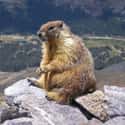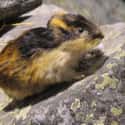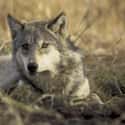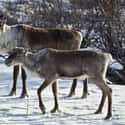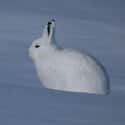-
(#10) Marmot
- Marmota
Marmots are large ground squirrels found in Asia, Europe, and North America. There are 15 identified species with some living in the Alps, northern Apennines, and Pyrenees mountains. Their preference is a cold and rocky climate, where they make burrowed nests to hibernate in for the winter. The Alpine Marmot is especially fond of cold climates, preferring to nest at heights of 10,500 feet (3,200 m).
They became extinct in the Pyrenees but were successfully reintroduced in 1948, and they continue to thrive there to this day. Due to the climate in which they live, they spend up to nine months out of the year hibernating. When they emerge, they spend most of their time gathering food and eating everything from grasses and herbs to spiders and worms. They aren't fans of warm weather and aren't active very much when the sun is out, even going so far as to forego eating rather than emerge from their burrows on a hot day.
Marmots were in the news in July 2020 after a young boy in Mongolia died after eating one. In doing so, he contracted the Bubonic Plague. Mongolia has recorded nearly 700 cases of Marmot plague between 1928 and 2018. Of those infected, 513 died, leading to a mortality rate of slightly more than 74%
-
(#14) Norway lemming
- Lemmus lemmus
Most people think of lemmings as suicidal rodents, but there is no validity to that widespread myth. Instead, they are small animals from the vole, and muskrat family found predominantly near Arctic tundra biomes. They are relatively small, measuring around six inches (15.5cm) in length, and weighing only around 0.8 - 1.2 oz (23 - 34 g).
Lemmings remain active during the harsh winter, where they burrow through the snow, creating large tunnel systems. This often protects them from predators, but they are a favorite snack of the Arctic fox and many other predators that call the tundra home. They are herbivorous, and subsist primarily on lichens and grasses, but have been known to forage for berries, leaves, bulbs, and roots deep in the snow.
-
(#3) Gray Wolf
- Canis lupus
Wolves are one of the most widely distributed and largest species of Canidae, and originally came from North America and Eurasia. These days, wolves are locally extirpated in Western Europe, most of the United States, Mexico, and Japan. Because of their adaptive nature, wolves can live in forests, shrublands, inland wetlands, grasslands, pastures, deserts, rocky peaks of mountains, and tundra.
Wolves thrive in Northern Eurasia and Greenland, where they can avoid human predation, making them a top-tier predator in their local ecosystem. Wolves are able to thrive in cold climates due to their thick fur and thick undercoat that helps keep them warm. They hunt in packs and are known to take down large deer and livestock, which brings them to the attention of ranchers and farmers.
-
(#6) Migratory Woodland Caribou
- Rangifer tarandus caribou
Caribou, or reindeer in many parts of the world, are large species of deer native to the Arctic and sub-Arctic tundra, boreal, and mountainous regions found in Siberia, North America, and northern Europe. Caribou are threatened and listed as "Vulnerable" by the IUCN, which has tracked herds across the world. The caribou of the contiguous United States was declared functionally extinct after its herd was reduced to only three individuals.
Caribou have evolved to adapt to the weather for optimal metabolic efficiency in the warm and cold months of the year. This is due to their ability to store energy for cold months, which is managed by what they eat and how they burn energy finding and consuming food. They consume lichens for their high concentration of carbohydrates to help achieve this, and the further south they wander, the less lichen they are seen eating.
-
(#9) Musk Ox
- Ovibos moschatus
The Muskox (sometimes "musk-ox" or "musk ox") is a species of Bovidae known for its thick coat and strong odor, which is used to attract mates during mating season. They are well known for this smell, but also their unusual look, which the Woods Cree noted in their name for it, which translates into "ugly bison." Muskox can be found in Greenland, Canada, Alaska, and Siberia.
Both the male and females have large, long curved horns ad long, thick fur. Wild muskoxen exist, but the species was domesticated recently. One domestication attempt carried out in the 1950s managed to develop a herd, which is primarily used for meat and wool. Their populations in the wild declined significantly throughout the 20th century due to overheating, though no threats exist for muskoxen in Greenland.
-
(#15) Arctic Hare
- Lepus arcticus
The Arctic hare is a species of hare that has completely adapted to live and prosper int he Arctic tundra. They are found in North America, Greenland, and the Arctic, where they typically live at elevations between sea level and 900 m. Unlike its southern cousins, the Arctic hare has short ears and a small nose, which helps in preventing heat loss.
Additionally, their bodies are approximately 20% fat, and their fur is thick, which helps to keep them warm. They dig holes in the snow to sleep and keep warm while avoiding predators. Often, they travel in small packs, which can include up to 80+ individuals that huddle together for warmth, though they are most often found alone. The Arctic hare is well-adapted to its environment, and it has the ability to run at a shockingly fast 40 mph (60 kph).
New Random Displays Display All By Ranking
About This Tool
The most representative tundra animals include arctic hares, thunderbirds, polar bears, and grizzly bears, etc. Animals that thrive in the tundra must evolve over time to adapt to the harsh climate and living conditions. The feature of the entire tundra is that there is a permafrost layer under the soil. This cold and humid environment causes physiological drought of plants and a lack of animal diversity.
Tundra is one of the coldest and arid regions in the world, but many very cool and unique animals live in the cold tundra which have evolved unique skills to adapt to survival and hunting. The random tool introduced the 15 coolest animals that live in the tundra.
Our data comes from Ranker, If you want to participate in the ranking of items displayed on this page, please click here.










